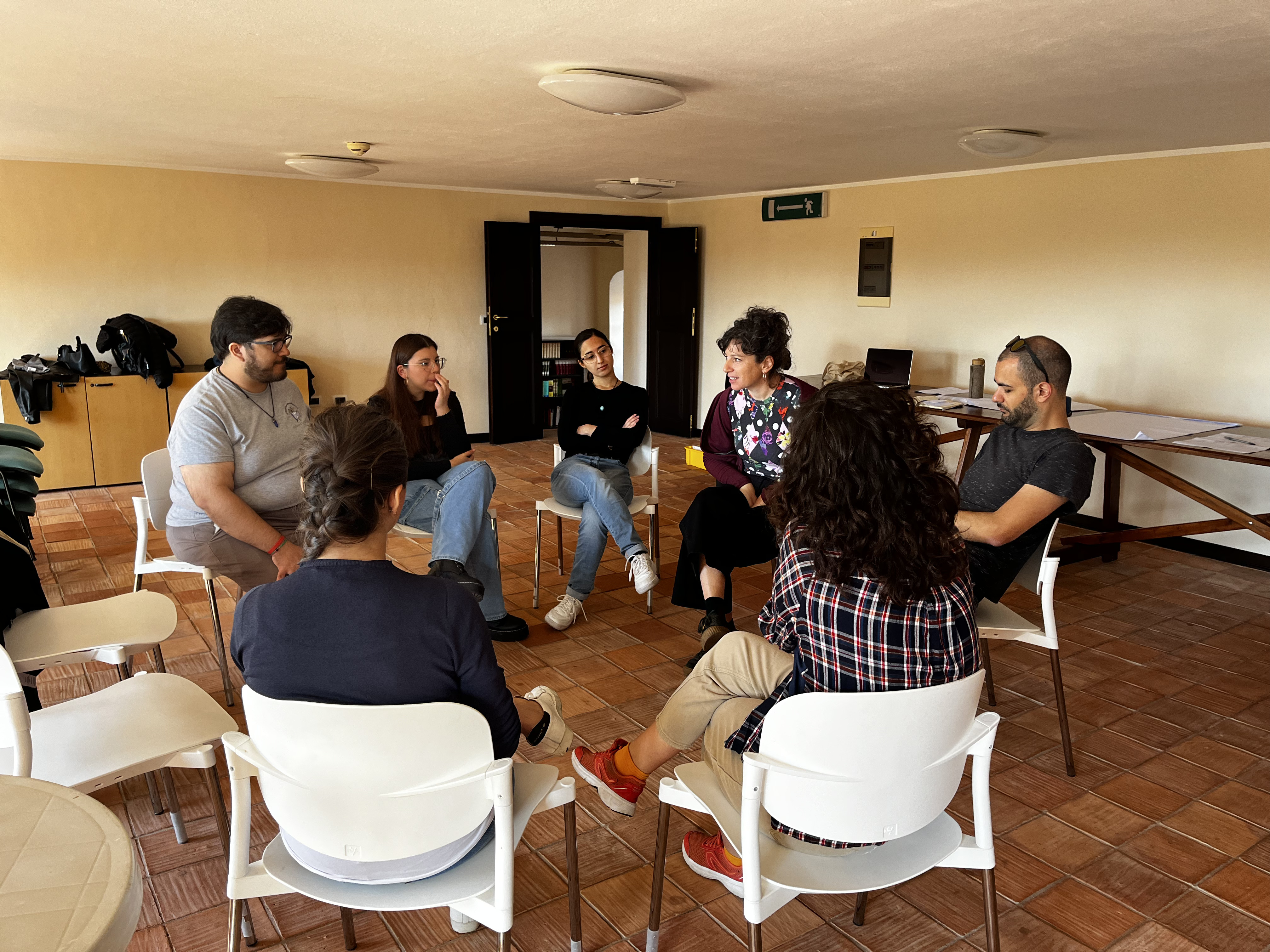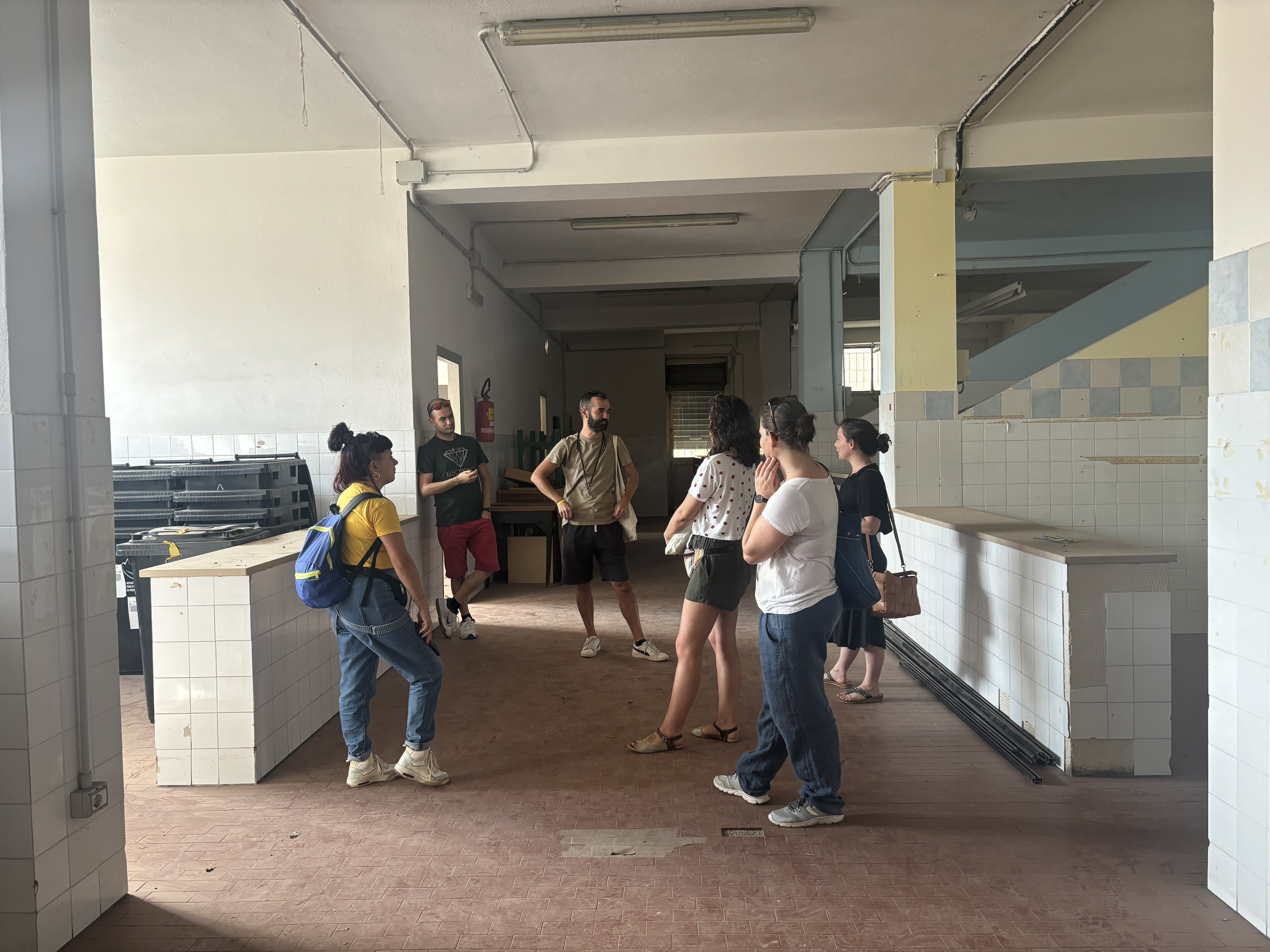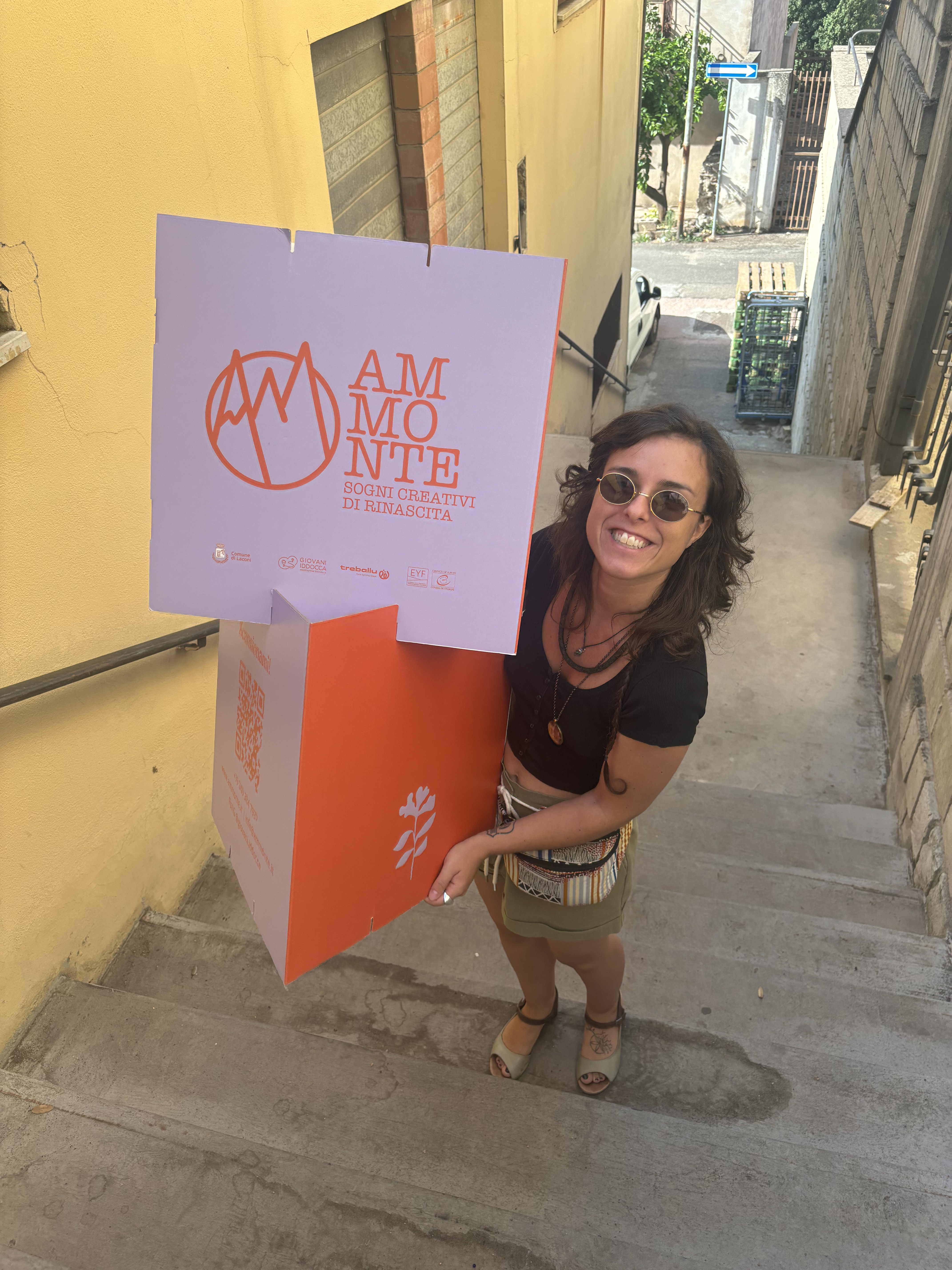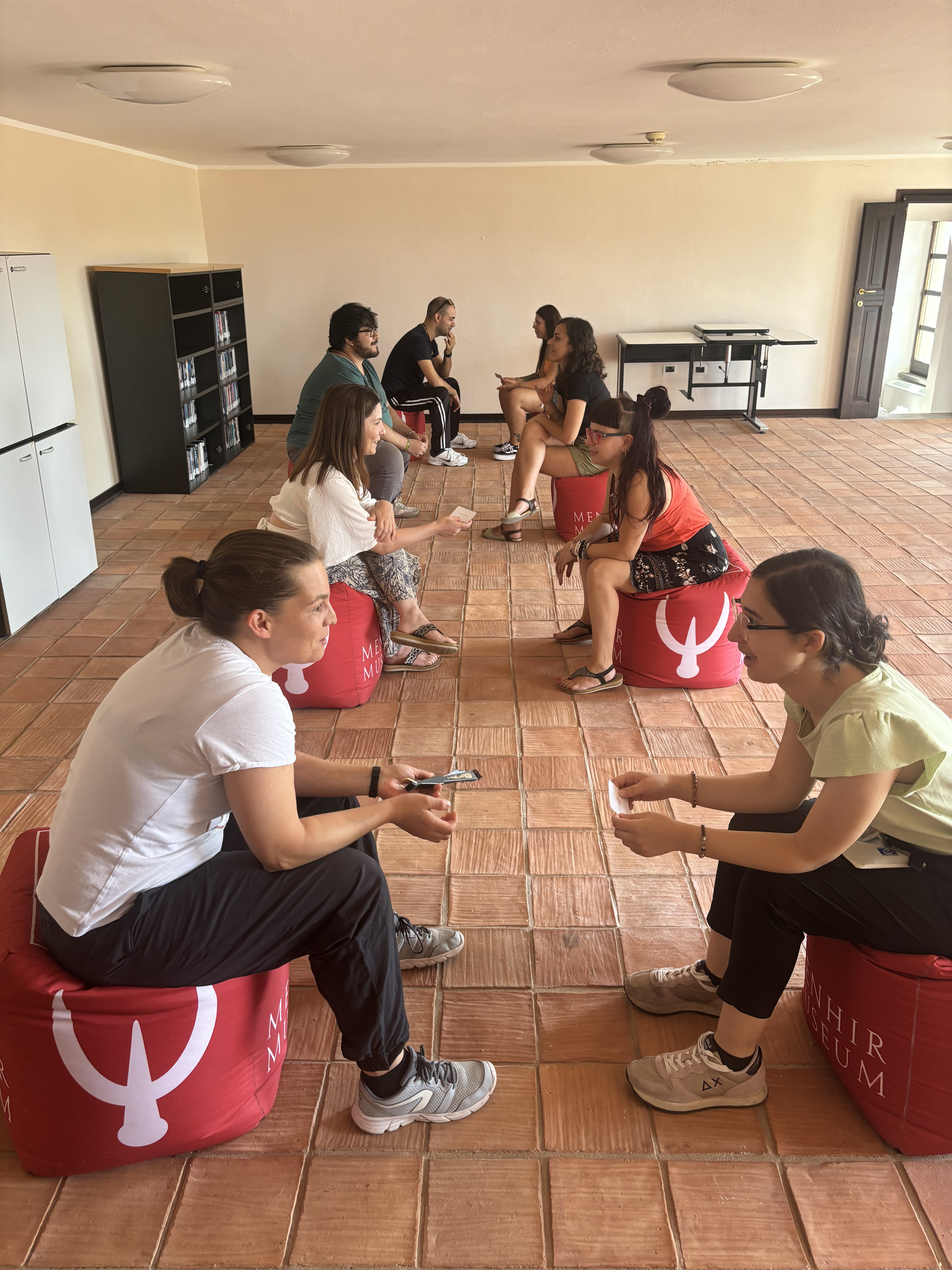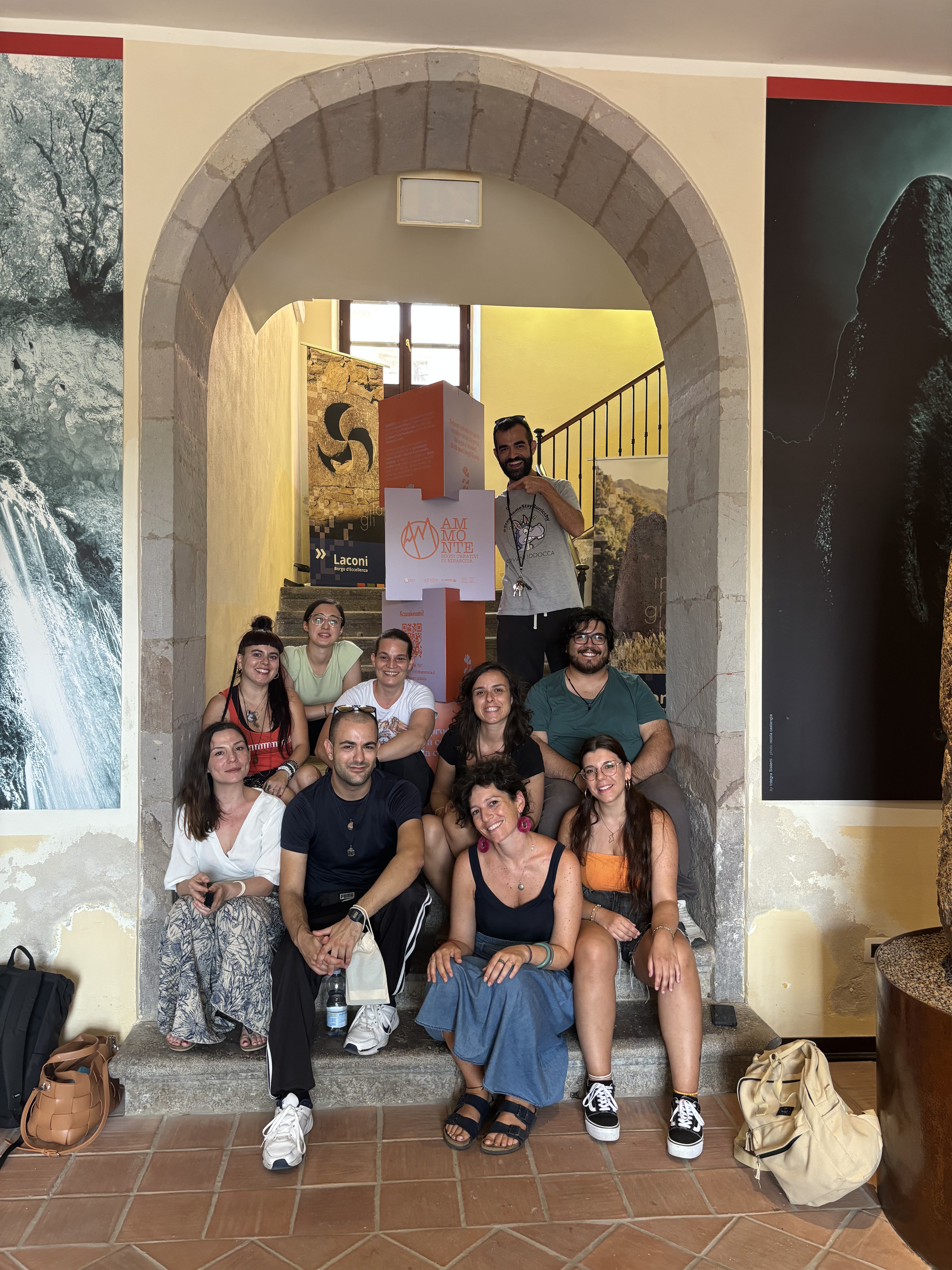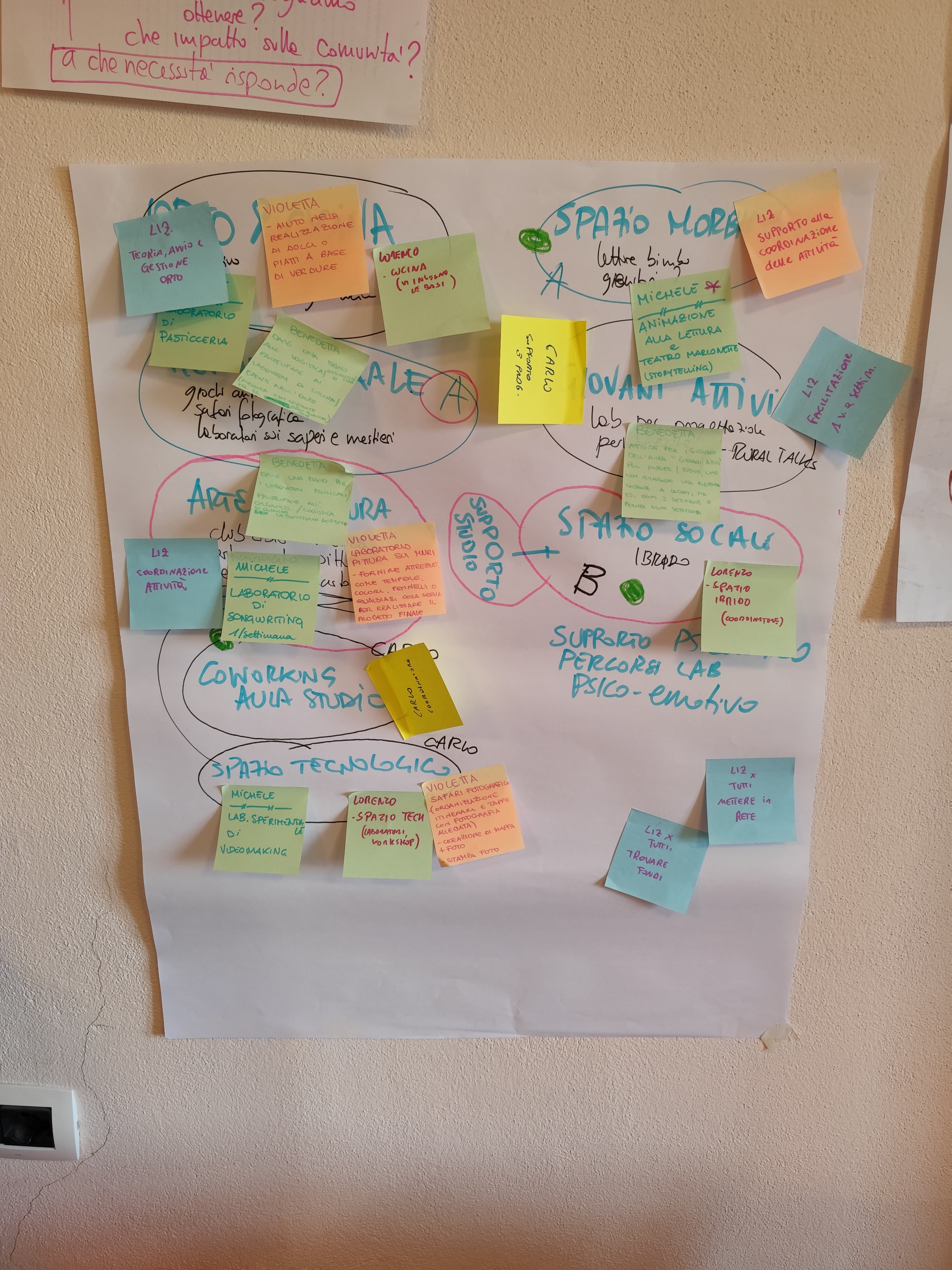Prioritising the places and people that need it the most
Ammonte
Ammonte - Urban, Cultural, and Social Regeneration Project in Laconi
Ammonte was a participatory design project that involved young people from Laconi and neighbouring rural areas to co-create the future of the former civic market, an abandoned public space in Laconi. Through workshops and community-led planning, the project activated and empowered rural youth and the entire community, making them protagonists in the regeneration of their communities.
Italy
Regional
Sardinia
Mainly rural
It refers to other types of transformations (soft investment)
Yes
2024-12-31
Yes
European Youth Foundation 2024
No
No
As a representative of an organisation
Ammonte was a participatory rural regeneration project that aimed to involve the community of Laconi and neighbouring towns in the design of the spaces and activities to be envisaged in the transformation of Laconi's former Civic Market into a Creative Rural Space. It aimed to counter depopulation and social fragmentation by creating an inclusive environment that fosters creativity, collaboration, and sustainable development. Instead of building anew, the project focused on repurposing an abandoned space, applying circular economy principles to urban renewal.
The initiative engaged young people as key drivers of community-led regeneration while involving local residents, artisans, and cultural organizations in shaping and using the space. Public institutions played a role in ensuring long-term sustainability. The project promoted intergenerational dialogue, youth participation, and social cohesion through shared decision-making while fostering sustainability by reducing waste and integrating resource-efficient practices.
Through workshops and training programs, Ammonte supported artistic, digital, and entrepreneurial skill development, creating a hub where tradition and modernity merged. The project revitalized the Civic Market by establishing thematic spaces, including a coworking and study area, a Rural Fab Lab combining craftsmanship with digital technology, a cultural hub for exhibitions and performances, and a community kitchen and garden to promote food sustainability.
By integrating local crafts, circular practices, and social innovation, Ammonte strengthened rural resilience. It became a model for rural regeneration, inspiring new regional and European networks that connect culture, circular economy, and community engagement.
The initiative engaged young people as key drivers of community-led regeneration while involving local residents, artisans, and cultural organizations in shaping and using the space. Public institutions played a role in ensuring long-term sustainability. The project promoted intergenerational dialogue, youth participation, and social cohesion through shared decision-making while fostering sustainability by reducing waste and integrating resource-efficient practices.
Through workshops and training programs, Ammonte supported artistic, digital, and entrepreneurial skill development, creating a hub where tradition and modernity merged. The project revitalized the Civic Market by establishing thematic spaces, including a coworking and study area, a Rural Fab Lab combining craftsmanship with digital technology, a cultural hub for exhibitions and performances, and a community kitchen and garden to promote food sustainability.
By integrating local crafts, circular practices, and social innovation, Ammonte strengthened rural resilience. It became a model for rural regeneration, inspiring new regional and European networks that connect culture, circular economy, and community engagement.
Participatory Design
Rural Regeneration
Youth Engagement
Community Empowerment
Sustainable Model Against Depopulation
Ammonte embraced sustainability by repurposing an abandoned public space, reducing the need for new construction and promoting a circular approach to urban regeneration. The project avoided urban sprawl and waste, transforming an existing structure and minimizing environmental impact. It promoted resource efficiency by integrating sustainable infrastructure and repurposed materials.
Ammonte also addressed social sustainability, responding to the need for shared, inclusive spaces. By activating a cultural and creative hub, it strengthened social cohesion, encouraged intergenerational exchange, and fostered belonging. The participatory approach ensured the space was shaped by and for the community, reinforcing its long-term relevance.
In a geographically isolated territory, where people feel like islands within an island, Ammonte played a crucial role in reconnecting communities. By involving young people from Laconi and neighboring villages, the project bridged distances, fostering collaboration, dialogue, and shared purpose. Through co-design workshops, participants built relationships based on common values, strengthening community ties.
Young people developed a long-term vision for the space, ensuring it remains adaptable and inclusive. Local stakeholders played a key role, fostering a sense of ownership that guarantees sustainability beyond the project.
By activating an inclusive hub, Ammonte provided opportunities for local entrepreneurship, supporting sustainable economic growth in a depopulating area. The project serves as a model for rural revitalization, showing how participatory regeneration of abandoned assets can combat depopulation and create resilient communities.
Ammonte stands out as a replicable model for rural areas, bridging circularity, social inclusion, and cultural vibrancy, redefining sustainability as a community-led process that values people, place, and environment equally.
Ammonte also addressed social sustainability, responding to the need for shared, inclusive spaces. By activating a cultural and creative hub, it strengthened social cohesion, encouraged intergenerational exchange, and fostered belonging. The participatory approach ensured the space was shaped by and for the community, reinforcing its long-term relevance.
In a geographically isolated territory, where people feel like islands within an island, Ammonte played a crucial role in reconnecting communities. By involving young people from Laconi and neighboring villages, the project bridged distances, fostering collaboration, dialogue, and shared purpose. Through co-design workshops, participants built relationships based on common values, strengthening community ties.
Young people developed a long-term vision for the space, ensuring it remains adaptable and inclusive. Local stakeholders played a key role, fostering a sense of ownership that guarantees sustainability beyond the project.
By activating an inclusive hub, Ammonte provided opportunities for local entrepreneurship, supporting sustainable economic growth in a depopulating area. The project serves as a model for rural revitalization, showing how participatory regeneration of abandoned assets can combat depopulation and create resilient communities.
Ammonte stands out as a replicable model for rural areas, bridging circularity, social inclusion, and cultural vibrancy, redefining sustainability as a community-led process that values people, place, and environment equally.
Ammonte places aesthetics and quality of experience at the heart of its participatory regeneration process, aiming at transforming an abandoned civic market into a vibrant cultural and creative hub. Through co-design, young people reimagined the space to reflect local identity, cultural expression, and contemporary community needs, ensuring a balance between tradition and innovation.
Rather than imposing a predefined architectural vision, the project prioritized co-creation, allowing youth and residents to shape a functional and welcoming space that resonates with Laconi’s heritage. By integrating design thinking and creative placemaking, Ammonte redefined the market’s purpose, making it adaptable to cultural and social activities. The space became a cultural incubator, offering a platform for artistic expression, creative industries, and community-driven events. It was envisioned to host exhibitions, performances, workshops, and co-creation labs, encouraging local talents to showcase their work and fostering new cultural dynamics in a rural setting.
Beyond its physical transformation, Ammonte focused on creating an inclusive and engaging environment. Addressing the lack of shared spaces, it became a meeting point for all ages, fostering social cohesion and a renewed sense of belonging. The participatory process itself was an empowering experience, as young people and community members actively shaped the space, strengthening their emotional connection to it.
Ammonte serves as a model of how aesthetics, cultural benefits, and community participation can revitalize underutilized rural spaces. By ensuring that design and artistic expression were deeply intertwined with social needs, the project demonstrated that beauty is not just an aesthetic element but a driver of social change, inclusion, and collective well-being.
Rather than imposing a predefined architectural vision, the project prioritized co-creation, allowing youth and residents to shape a functional and welcoming space that resonates with Laconi’s heritage. By integrating design thinking and creative placemaking, Ammonte redefined the market’s purpose, making it adaptable to cultural and social activities. The space became a cultural incubator, offering a platform for artistic expression, creative industries, and community-driven events. It was envisioned to host exhibitions, performances, workshops, and co-creation labs, encouraging local talents to showcase their work and fostering new cultural dynamics in a rural setting.
Beyond its physical transformation, Ammonte focused on creating an inclusive and engaging environment. Addressing the lack of shared spaces, it became a meeting point for all ages, fostering social cohesion and a renewed sense of belonging. The participatory process itself was an empowering experience, as young people and community members actively shaped the space, strengthening their emotional connection to it.
Ammonte serves as a model of how aesthetics, cultural benefits, and community participation can revitalize underutilized rural spaces. By ensuring that design and artistic expression were deeply intertwined with social needs, the project demonstrated that beauty is not just an aesthetic element but a driver of social change, inclusion, and collective well-being.
Ammonte placed inclusion at the center of its participatory regeneration process, ensuring that the transformation of the abandoned civic market responded to the needs of a diverse and rural community. The project actively engaged young people, local stakeholders, and residents of all backgrounds, creating an accessible, affordable, and shared space shaped through collective decision-making.
By involving youth from Laconi and neighboring villages, Ammonte bridged geographical and social isolation, bringing together individuals who often feel disconnected due to the lack of common spaces in rural areas. The participatory process ensured that all voices were heard, fostering a governance model based on inclusivity and shared responsibility. Young people, often excluded from local decision-making, became protagonists in shaping a space that reflected their aspirations, ensuring a sense of ownership and long-term sustainability.
The project promoted physical and social accessibility by designing a space open to all, regardless of age, socio-economic status, or background. Provided free participation in the activities and supported in covering the costs of food and accommodation during the activities, ensuring that cultural, educational, and entrepreneurial activities were accessible to those with fewer opportunities.
Ammonte serves as a replicable model for rural regeneration, demonstrating how inclusive governance, participatory design, and affordability can create sustainable and accessible community spaces. By fostering a culture of co-creation, the project redefined public space as a shared asset, showing that inclusion is not just about physical access but about ensuring equal participation, representation, and long-term community engagement.
By involving youth from Laconi and neighboring villages, Ammonte bridged geographical and social isolation, bringing together individuals who often feel disconnected due to the lack of common spaces in rural areas. The participatory process ensured that all voices were heard, fostering a governance model based on inclusivity and shared responsibility. Young people, often excluded from local decision-making, became protagonists in shaping a space that reflected their aspirations, ensuring a sense of ownership and long-term sustainability.
The project promoted physical and social accessibility by designing a space open to all, regardless of age, socio-economic status, or background. Provided free participation in the activities and supported in covering the costs of food and accommodation during the activities, ensuring that cultural, educational, and entrepreneurial activities were accessible to those with fewer opportunities.
Ammonte serves as a replicable model for rural regeneration, demonstrating how inclusive governance, participatory design, and affordability can create sustainable and accessible community spaces. By fostering a culture of co-creation, the project redefined public space as a shared asset, showing that inclusion is not just about physical access but about ensuring equal participation, representation, and long-term community engagement.
Ammonte fully adhers to the three working principles of the New European Bauhaus by placing the community at the heart of the regeneration of the former civic market. The project ensured that citizens, particularly young people, were not just beneficiaries but active co-creators, shaping both the vision and the implementation of the initiative.
The participatory process engaged youth, local residents, and civil society organizations through a series of co-design workshops, public consultations, interviews, questionnaires and collaborative decision-making sessions. These activities provided a platform for dialogue and collective visioning, ensuring that the final outcomes reflected the real needs and aspirations of the community. Young people, often excluded from local governance, played a leading role, developing proposals, envisioning uses for the space, and contributing to its long-term sustainability.
Ammonte also fostered multi-level engagement, involving local institutions, cultural associations, and experts in the fields of urban regeneration, sustainability, and social innovation. This cross-sector collaboration bridged different levels of expertise, ensuring that the project combined local knowledge with professional insights. The involvement of diverse stakeholders strengthened the governance model, encouraging long-term commitment to the space’s development.
By adopting a transdisciplinary approach, Ammonte merged urban planning, cultural programming, and community engagement. The impact of this involvement was profound—residents reclaimed ownership of their public space, young people gained decision-making experience, and civil society built stronger networks of collaboration.
Ammonte stands as a replicable model, proving that participatory governance, multi-stakeholder collaboration, and interdisciplinary methods can revitalize rural spaces while strengthening community resilience and shared responsibility.
The participatory process engaged youth, local residents, and civil society organizations through a series of co-design workshops, public consultations, interviews, questionnaires and collaborative decision-making sessions. These activities provided a platform for dialogue and collective visioning, ensuring that the final outcomes reflected the real needs and aspirations of the community. Young people, often excluded from local governance, played a leading role, developing proposals, envisioning uses for the space, and contributing to its long-term sustainability.
Ammonte also fostered multi-level engagement, involving local institutions, cultural associations, and experts in the fields of urban regeneration, sustainability, and social innovation. This cross-sector collaboration bridged different levels of expertise, ensuring that the project combined local knowledge with professional insights. The involvement of diverse stakeholders strengthened the governance model, encouraging long-term commitment to the space’s development.
By adopting a transdisciplinary approach, Ammonte merged urban planning, cultural programming, and community engagement. The impact of this involvement was profound—residents reclaimed ownership of their public space, young people gained decision-making experience, and civil society built stronger networks of collaboration.
Ammonte stands as a replicable model, proving that participatory governance, multi-stakeholder collaboration, and interdisciplinary methods can revitalize rural spaces while strengthening community resilience and shared responsibility.
Ammonte engaged stakeholders at multiple levels—local, regional, national, and European—ensuring a participatory regeneration process. Each level contributed expertise, resources, and support, strengthening the project’s impact.
At the local level, young people from Laconi and nearby villages were the driving force, actively participating in co-design workshops and decision-making sessions to shape the former civic market. Civil society organizations mobilized residents, while the municipal administration provided institutional backing, recognizing the space as a community asset.
At the regional level, rural development organizations and cultural institutions broadened the project’s reach, fostering collaboration between villages facing similar challenges. These actors facilitated knowledge exchange and networking, linking Ammonte to other regeneration initiatives in Sardinia.
At the national level, Ammonte is recognized as a model of sustainable creative space and is presented within the emerging national network of collaborative spaces led by Officine On/Off. This initiative connects spaces across Italy, promoting sustainability management and enhancing local impact.
At the European level, Ammonte is part of CRAB - Creative Habitat, a project uniting coworking and coliving spaces from Southern Europe. CRAB aims to formalize and expand this network, strengthening cooperation between creative rural spaces. Ammonte contributes to developing shared tools, facilitating knowledge exchange and resource-sharing.
This multi-level engagement ensured Ammonte was deeply rooted locally while benefiting from broader insights, turning a rural initiative into a scalable model for participatory regeneration with lasting impact.
At the local level, young people from Laconi and nearby villages were the driving force, actively participating in co-design workshops and decision-making sessions to shape the former civic market. Civil society organizations mobilized residents, while the municipal administration provided institutional backing, recognizing the space as a community asset.
At the regional level, rural development organizations and cultural institutions broadened the project’s reach, fostering collaboration between villages facing similar challenges. These actors facilitated knowledge exchange and networking, linking Ammonte to other regeneration initiatives in Sardinia.
At the national level, Ammonte is recognized as a model of sustainable creative space and is presented within the emerging national network of collaborative spaces led by Officine On/Off. This initiative connects spaces across Italy, promoting sustainability management and enhancing local impact.
At the European level, Ammonte is part of CRAB - Creative Habitat, a project uniting coworking and coliving spaces from Southern Europe. CRAB aims to formalize and expand this network, strengthening cooperation between creative rural spaces. Ammonte contributes to developing shared tools, facilitating knowledge exchange and resource-sharing.
This multi-level engagement ensured Ammonte was deeply rooted locally while benefiting from broader insights, turning a rural initiative into a scalable model for participatory regeneration with lasting impact.
Ammonte integrated diverse disciplines and knowledge fields, fostering a transdisciplinary approach where urban regeneration, community engagement, cultural management, and sustainability converged. The interaction between these fields enriched the participatory process, ensuring the project was socially inclusive, structurally sound, and environmentally sustainable.
Urban regeneration and participatory design played a key role, as young people and local stakeholders collaborated with planners, architects, and facilitators to rethink the former civic market. The co-design process emphasized adaptive reuse, transforming an abandoned structure into a flexible, multi-purpose space.
Social sciences and community development ensured regeneration efforts were deeply connected to Laconi’s social fabric. Experts in youth participation and civic engagement guided discussions, creating a governance model based on co-creation and shared responsibility. This strengthened social cohesion and inclusivity, making the space accessible to all.
Cultural management and creative industries shaped Ammonte’s role as a hub for artistic expression and local entrepreneurship. Artists, cultural organizations, and creative professionals contributed to defining cultural programming, fostering innovation and economic opportunities.
Sustainability and circular economy principles were embedded in the project, with experts advising on low-impact solutions and resource efficiency. The participatory process promoted awareness of sustainable urban practices, reinforcing a long-term ecological vision for the space.
The added value of this interdisciplinary approach was the creation of a dynamic, adaptable, and inclusive space, where different knowledge fields enriched one another, resulting in a coherent, community-led model of rural regeneration.
Urban regeneration and participatory design played a key role, as young people and local stakeholders collaborated with planners, architects, and facilitators to rethink the former civic market. The co-design process emphasized adaptive reuse, transforming an abandoned structure into a flexible, multi-purpose space.
Social sciences and community development ensured regeneration efforts were deeply connected to Laconi’s social fabric. Experts in youth participation and civic engagement guided discussions, creating a governance model based on co-creation and shared responsibility. This strengthened social cohesion and inclusivity, making the space accessible to all.
Cultural management and creative industries shaped Ammonte’s role as a hub for artistic expression and local entrepreneurship. Artists, cultural organizations, and creative professionals contributed to defining cultural programming, fostering innovation and economic opportunities.
Sustainability and circular economy principles were embedded in the project, with experts advising on low-impact solutions and resource efficiency. The participatory process promoted awareness of sustainable urban practices, reinforcing a long-term ecological vision for the space.
The added value of this interdisciplinary approach was the creation of a dynamic, adaptable, and inclusive space, where different knowledge fields enriched one another, resulting in a coherent, community-led model of rural regeneration.
Ammonte stands out as an innovative approach to urban and social regeneration, diverging from mainstream practices by placing youth-led participatory design, rural sustainability, and community co-creation at its core. Unlike traditional top-down models, Ammonte empowered young people and local residents to shape the transformation of an abandoned public space, fostering a shared sense of ownership and long-term commitment.
A key innovation was its co-design methodology, replacing conventional planning approaches with inclusive, interactive workshops. Instead of relying on external consultants, Ammonte enabled young participants to envision, debate, and collaboratively shape its purpose, ensuring alignment with real community needs.
Ammonte also introduced a rural-focused model for creative spaces, challenging the idea that cultural and entrepreneurial hubs are exclusive to urban areas. By transforming the former civic market into a cultural incubator, the project proved that rural communities can drive innovation, artistic expression, and local economic development, reversing the trend of youth migration to cities.
Unlike mainstream regeneration projects, which prioritize physical renovation, Ammonte focused on building social capital first, ensuring that the space’s function was defined by its users. This process-over-product approach guaranteed long-term engagement and sustainability, making it a replicable model for small communities facing depopulation.
By embedding sustainability and circular principles, Ammonte promoted resource efficiency and low-impact development, proving that rural regeneration can be both environmentally conscious and socially inclusive. Through its bottom-up approach, Ammonte redefined rural revitalization, showing that creative spaces can flourish beyond urban settings.
A key innovation was its co-design methodology, replacing conventional planning approaches with inclusive, interactive workshops. Instead of relying on external consultants, Ammonte enabled young participants to envision, debate, and collaboratively shape its purpose, ensuring alignment with real community needs.
Ammonte also introduced a rural-focused model for creative spaces, challenging the idea that cultural and entrepreneurial hubs are exclusive to urban areas. By transforming the former civic market into a cultural incubator, the project proved that rural communities can drive innovation, artistic expression, and local economic development, reversing the trend of youth migration to cities.
Unlike mainstream regeneration projects, which prioritize physical renovation, Ammonte focused on building social capital first, ensuring that the space’s function was defined by its users. This process-over-product approach guaranteed long-term engagement and sustainability, making it a replicable model for small communities facing depopulation.
By embedding sustainability and circular principles, Ammonte promoted resource efficiency and low-impact development, proving that rural regeneration can be both environmentally conscious and socially inclusive. Through its bottom-up approach, Ammonte redefined rural revitalization, showing that creative spaces can flourish beyond urban settings.
Ammonte adopted a participatory and community-driven methodology, ensuring the transformation of the former civic market was guided by its future users. The approach combined co-design, social innovation, and sustainability, integrating bottom-up decision-making, interdisciplinary collaboration, and long-term community engagement.
The co-design process placed young people at the center of decision-making through interactive workshops and collaborative planning exercises. Instead of imposing predefined solutions, Ammonte facilitated open discussions where participants analyzed community needs, envisioned future uses, and shaped the space’s identity. This ensured the project reflected local aspirations rather than external priorities.
A key part of the methodology was multi-stakeholder engagement, involving youth, residents, local associations, and institutions. This strengthened social cohesion, ensuring diverse perspectives were represented and fostering collective ownership of the space.
Ammonte integrated learning-by-doing and peer-to-peer exchange, guided by facilitators and experts in urban regeneration, sustainability, and cultural management. This hands-on approach helped young people develop skills in project planning and civic engagement, reinforcing their role as active agents of change.
The project embraced sustainability principles, promoting adaptive reuse, resource efficiency, and circularity. Rather than focusing solely on renovation, Ammonte prioritized revitalizing the space’s social function, ensuring it remained flexible and community-driven.
By combining inclusive governance, participatory design, and sustainability, Ammonte created a scalable model for community-led rural regeneration. This approach transformed an abandoned space while empowering communities to drive their own cultural and social revitalization.
The co-design process placed young people at the center of decision-making through interactive workshops and collaborative planning exercises. Instead of imposing predefined solutions, Ammonte facilitated open discussions where participants analyzed community needs, envisioned future uses, and shaped the space’s identity. This ensured the project reflected local aspirations rather than external priorities.
A key part of the methodology was multi-stakeholder engagement, involving youth, residents, local associations, and institutions. This strengthened social cohesion, ensuring diverse perspectives were represented and fostering collective ownership of the space.
Ammonte integrated learning-by-doing and peer-to-peer exchange, guided by facilitators and experts in urban regeneration, sustainability, and cultural management. This hands-on approach helped young people develop skills in project planning and civic engagement, reinforcing their role as active agents of change.
The project embraced sustainability principles, promoting adaptive reuse, resource efficiency, and circularity. Rather than focusing solely on renovation, Ammonte prioritized revitalizing the space’s social function, ensuring it remained flexible and community-driven.
By combining inclusive governance, participatory design, and sustainability, Ammonte created a scalable model for community-led rural regeneration. This approach transformed an abandoned space while empowering communities to drive their own cultural and social revitalization.
Ammonte’s approach to participatory urban regeneration offers a highly transferable model, particularly for rural areas facing depopulation and lack of community spaces. Its methodology, governance model, and sustainability principles can be adapted to other contexts, ensuring abandoned public spaces are reclaimed through community-led processes.
At its core, Ammonte is based on the belief that revitalizing rural communities improves life for residents, encourages them to stay, and makes these areas attractive to newcomers. By fostering vibrant, inclusive, and creative spaces, rural villages become more welcoming to those looking to relocate, countering depopulation with sustainable, community-driven initiatives.
The co-design methodology is highly replicable. The interactive workshops, collaborative decision-making, and youth engagement strategies used in Ammonte can be applied in any community seeking to revitalize a space through inclusive and participatory planning.
Ammonte also introduced a sustainable model for creative and cultural hubs in rural areas, proving that small communities can foster innovation and economic growth. The idea of repurposing abandoned public assets into multifunctional spaces is relevant for villages or shrinking towns seeking to retain young people and attract creative industries.
The project’s governance model, based on shared ownership and collaboration, provides a blueprint for self-sustaining, community-led spaces. The process of engaging local administrations, civil society organizations, and national networks can be transferred to any context where institutional support is needed.
Ammonte’s focus on adaptive reuse and circular principles can inspire other regeneration projects to prioritize resource-efficient transformations. Its emphasis on building social capital before renovation ensures spaces remain community-driven, making it a scalable model for rural revitalization across Europe.
At its core, Ammonte is based on the belief that revitalizing rural communities improves life for residents, encourages them to stay, and makes these areas attractive to newcomers. By fostering vibrant, inclusive, and creative spaces, rural villages become more welcoming to those looking to relocate, countering depopulation with sustainable, community-driven initiatives.
The co-design methodology is highly replicable. The interactive workshops, collaborative decision-making, and youth engagement strategies used in Ammonte can be applied in any community seeking to revitalize a space through inclusive and participatory planning.
Ammonte also introduced a sustainable model for creative and cultural hubs in rural areas, proving that small communities can foster innovation and economic growth. The idea of repurposing abandoned public assets into multifunctional spaces is relevant for villages or shrinking towns seeking to retain young people and attract creative industries.
The project’s governance model, based on shared ownership and collaboration, provides a blueprint for self-sustaining, community-led spaces. The process of engaging local administrations, civil society organizations, and national networks can be transferred to any context where institutional support is needed.
Ammonte’s focus on adaptive reuse and circular principles can inspire other regeneration projects to prioritize resource-efficient transformations. Its emphasis on building social capital before renovation ensures spaces remain community-driven, making it a scalable model for rural revitalization across Europe.
Ammonte addresses global challenges such as rural depopulation, social fragmentation, lack of youth engagement, and the need for sustainable urban regeneration, providing local, community-driven solutions that can be replicated in similar contexts worldwide.
One of the most pressing challenges is rural depopulation, a widespread issue across Europe and beyond. Many young people leave small towns due to limited opportunities, lack of cultural spaces, and economic stagnation. Ammonte tackles this by revitalizing an abandoned public space, transforming it into a creative and social hub where young people can connect, collaborate, and build new opportunities within their own communities. This approach encourages people to stay and makes the area more attractive to newcomers, fostering a sustainable and thriving rural environment.
The project also responds to social fragmentation and the loss of shared spaces in small communities. In many rural areas, there are few public places where people can meet, exchange ideas, and participate in cultural and educational activities. Ammonte provides a physical and social space for inclusion, reinforcing social ties and intergenerational exchange.
Another global challenge Ammonte addresses is the sustainable reuse of abandoned spaces. Many towns suffer from urban decay as buildings lose their function and fall into disrepair. Instead of demolishing and rebuilding, Ammonte demonstrates how adaptive reuse and participatory regeneration can bring new life to existing structures while minimizing environmental impact.
The project also supports youth engagement and democratic participation, empowering young people to take an active role in shaping their environment. By giving them a voice in decision-making, Ammonte fosters civic responsibility and a culture of collaboration, proving that inclusive governance and bottom-up regeneration can be key solutions to rural sustainability worldwide.
One of the most pressing challenges is rural depopulation, a widespread issue across Europe and beyond. Many young people leave small towns due to limited opportunities, lack of cultural spaces, and economic stagnation. Ammonte tackles this by revitalizing an abandoned public space, transforming it into a creative and social hub where young people can connect, collaborate, and build new opportunities within their own communities. This approach encourages people to stay and makes the area more attractive to newcomers, fostering a sustainable and thriving rural environment.
The project also responds to social fragmentation and the loss of shared spaces in small communities. In many rural areas, there are few public places where people can meet, exchange ideas, and participate in cultural and educational activities. Ammonte provides a physical and social space for inclusion, reinforcing social ties and intergenerational exchange.
Another global challenge Ammonte addresses is the sustainable reuse of abandoned spaces. Many towns suffer from urban decay as buildings lose their function and fall into disrepair. Instead of demolishing and rebuilding, Ammonte demonstrates how adaptive reuse and participatory regeneration can bring new life to existing structures while minimizing environmental impact.
The project also supports youth engagement and democratic participation, empowering young people to take an active role in shaping their environment. By giving them a voice in decision-making, Ammonte fosters civic responsibility and a culture of collaboration, proving that inclusive governance and bottom-up regeneration can be key solutions to rural sustainability worldwide.
Ammonte has achieved significant results by transforming an abandoned civic market into a vibrant, community-driven cultural and creative hub. The project directly impacted young people and the local population while offering a replicable model for other rural areas facing similar challenges.
One key outcome was the involvement of over 30 young people in co-design workshops, where they shaped the space’s future. More than 100 residents took part in public consultations and participatory events, reinforcing social cohesion and fostering a renewed sense of belonging. This collective effort led to a structured regeneration plan, ensuring that the transformation reflected real local needs.
The project also emphasized knowledge transfer and skill-building. Participants gained experience in participatory design, community engagement, and social entrepreneurship, equipping them to take an active role in their town’s future. Ammonte’s methodology was documented, providing a reference for other rural areas seeking to implement similar processes.
For young people, Ammonte created a space for expression, connection, and learning, strengthening their role in shaping their town. The local community gained a meeting place that encouraged interaction and intergenerational exchange, addressing the long-standing lack of shared spaces. Local institutions and organizations recognized the project as an example of inclusive, bottom-up regeneration, demonstrating the potential of collaborative governance models.
Beyond its immediate impact, Ammonte serves as a scalable solution for rural revitalization. It shows that abandoned spaces can become hubs for social, economic, and cultural renewal, making small communities more livable, attractive, and sustainable while offering a model that can inspire similar initiatives elsewhere.
One key outcome was the involvement of over 30 young people in co-design workshops, where they shaped the space’s future. More than 100 residents took part in public consultations and participatory events, reinforcing social cohesion and fostering a renewed sense of belonging. This collective effort led to a structured regeneration plan, ensuring that the transformation reflected real local needs.
The project also emphasized knowledge transfer and skill-building. Participants gained experience in participatory design, community engagement, and social entrepreneurship, equipping them to take an active role in their town’s future. Ammonte’s methodology was documented, providing a reference for other rural areas seeking to implement similar processes.
For young people, Ammonte created a space for expression, connection, and learning, strengthening their role in shaping their town. The local community gained a meeting place that encouraged interaction and intergenerational exchange, addressing the long-standing lack of shared spaces. Local institutions and organizations recognized the project as an example of inclusive, bottom-up regeneration, demonstrating the potential of collaborative governance models.
Beyond its immediate impact, Ammonte serves as a scalable solution for rural revitalization. It shows that abandoned spaces can become hubs for social, economic, and cultural renewal, making small communities more livable, attractive, and sustainable while offering a model that can inspire similar initiatives elsewhere.

